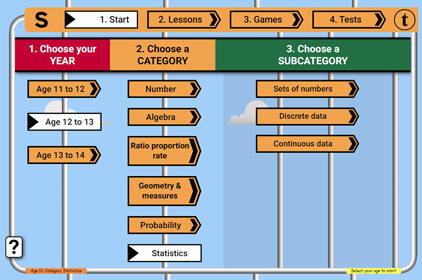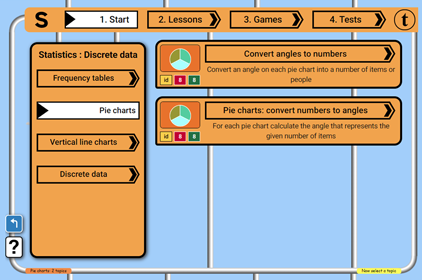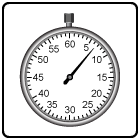


7th grade Probability topics for Secondary math learners
| Topic icon key | ||
eq | Equation | Each item in the topic is in the form of an equation |
id | Identify | Each item in the topic is a thing |
mi | Missing item | Each item in the topic is a statement with a missing term |
10 | Number of items | There are 10 items in this topic |
8 | Extended items | Additional questions for games and tests in this topic |
Our math topics for 7th grade learners are designed to follow closely the Common Core standards for math for 7th grade pupils.
Probability syllabus for 7th grade
Here are some key aspects of the math curriculum for probability for students aged 12 to 13:
Experimental and Theoretical Probability: Students continue to explore experimental and theoretical probability. They conduct experiments, collect data, and compare it with theoretical probabilities. They learn to identify biases and limitations in data collection and understand how sample size affects the reliability of experimental results.
Counting Techniques: Students learn various counting techniques, such as the fundamental counting principle, permutations, and combinations. They apply these techniques to determine the total number of possible outcomes and calculate probabilities in more complex scenarios.
Probability Models: Students learn to create and use probability models, such as probability tables, Venn diagrams, and two-way tables. They use these models to organize and analyze data, calculate probabilities, and solve problems involving multiple events.
Probability of Compound Events: Students deepen their understanding of compound events. They learn to calculate the probability of compound events using addition, multiplication, and subtraction rules. They explore the concept of mutually exclusive and independent events and use conditional probability to solve problems.
Tree Diagrams and Sample Spaces: Students continue to use tree diagrams and sample spaces to represent and analyze possible outcomes of events. They use tree diagrams to calculate probabilities of compound events and solve problems involving sequential events.
Probability Distributions: Students explore probability distributions, including discrete and continuous probability distributions. They learn to construct and interpret probability distribution tables and histograms. They calculate measures such as mean, median, and mode to describe and analyze probability distributions.
Experimental Probability and Frequency: Students investigate the relationship between experimental probability and long-term frequency. They learn that as the number of trials or experiments increases, the experimental probability tends to approach the theoretical probability. They use this understanding to make predictions and draw conclusions.
Conditional Probability: Students delve into conditional probability and learn to calculate the probability of an event occurring given that another event has already occurred. They use conditional probability to analyze real-world situations and solve problems involving dependent events.
Probability and Statistics: Students explore the connection between probability and statistics. They learn to interpret and analyze data using probability concepts, such as expected value, relative frequency, and likelihood ratios. They apply probability principles to make predictions and draw conclusions based on data.
Probability in Decision Making: Students apply probability concepts to make informed decisions in various contexts. They consider risks, uncertainties, and probabilities to evaluate options, solve problems, and make predictions. They develop critical thinking skills to analyze and interpret probability information in decision-making processes.
Throughout the curriculum, students engage in problem-solving activities, simulations, and real-life applications to reinforce their understanding of probability. They develop their skills in data analysis, critical thinking, logical reasoning, and mathematical communication.
A topic is selected at the beginning of a session at Free Math Games and will be remembered when you move between games or activities. The math for the topic is carefully constructed to match the level of difficulty taught in US schools. This means that you as a secondary pupil should see similar math problems to those you are seeing at school (if you are at school) for any particular subject. Please let us know if that is not the case.
See the help box below for instructions on choosing a topic here at Free Math Games.
UXO * Duck shoot * The frog flies * Pong * Cat and mouse * The beetle and the bee
Rock fall * Four in a row * Sow grow * Choose or lose * Mix and match





How to choose a 7th grade Probability topic for Secondary math

Click on the "1. Start" button in the top navigation bar - that brings you to this Secondary level topic selection page. On the topic selection page you will see that the topics are divided up:
- By level (Preschool, Elementary and Secondary)
- By grade (6th to 8th for this level)
- Into broad categories
Since you are currently within the Secondary section of Free Math Games you will see the Secondary topics. The Secondary grades will have loaded. Choose your grade. The broad categories available will load. Click on a category to see the available sub-categories and topics.

For example, if you choose 7th grade, then the category: "Algebra" and the sub-category "Sequences" you will be offered a choice of sub-sub-categories and topics suitable for your school grade - in the case of this example, "Generating terms" and "nth term expressions". Click on each sub-sub-category to view the available topics.
When you click on the name of a topic, the topic will load into the lesson page (once a topic has loaded it will be available for all activities and will not have to be downloaded again) and the lesson start page will be displayed. You can choose to do the lesson or jump immediately to the games using that topic.











